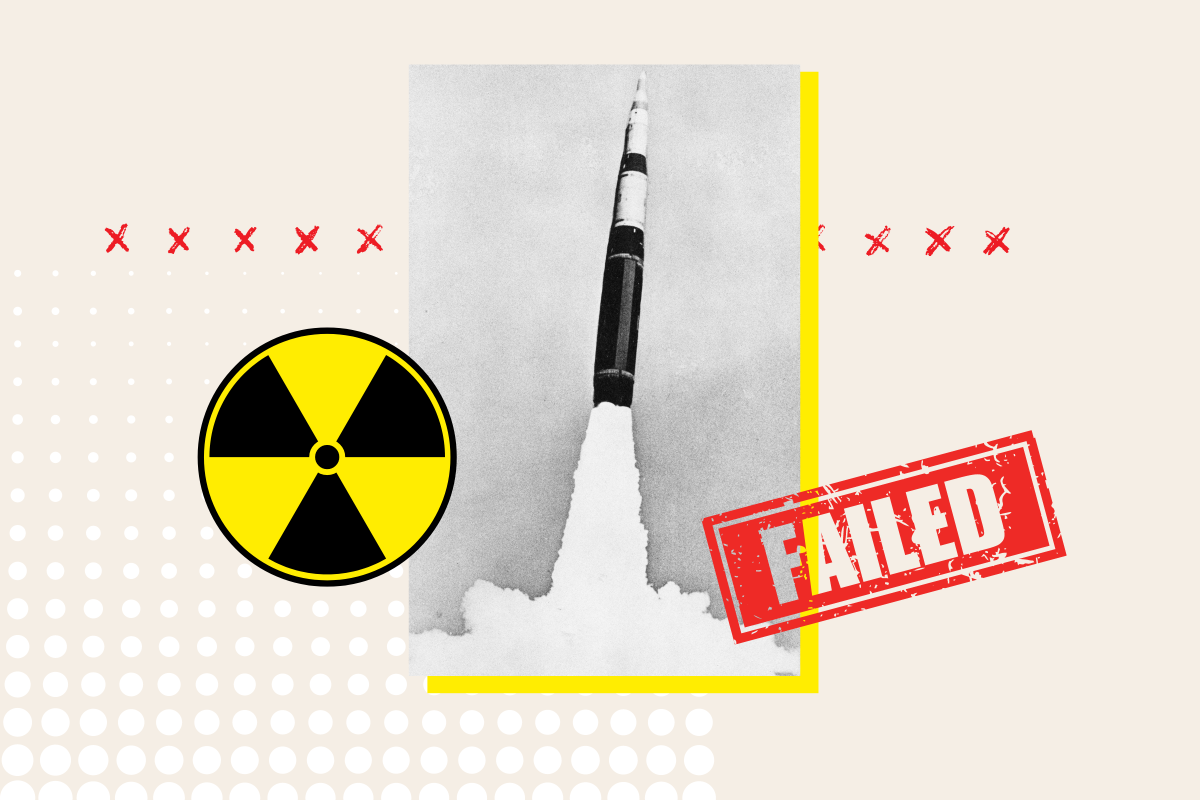The backbone of the U.S.'s national security—that is how Washington has long seen its nuclear deterrent. Since the advent of the atomic age, maintaining a powerful, credible nuclear arsenal that is ready to go on a moment's notice has been at the very top of the priority list in D.C.'s corridors of power.
But the U.S.'s nukes are old. Faced with the rapid development taking place in China and a more aggressive, unpredictable Russia, there are deep concerns over whether the U.S. has been funneling enough resources into modernizing its capabilities on time as an unpredictable future lurks around the corner.
"The next five years—maybe less than that—will be really determinative," said Heather Williams, who heads up the Project on Nuclear Issues and is a senior fellow with the Center for Strategic and International Studies (CSIS) think tank.

The U.S. is replacing its aged Minuteman IIIs with Sentinels, completing a massive overhaul of the ground-based deterrent while swapping out the veteran Ohio-class submarines for the forthcoming Columbia class. The stealthy B-21 Raider is set to swoop in as part of the dual-capable air leg of the triad, eventually ousting B-2 heavy bombers, and the F-35 fighter has now been certified to carry the B61-12 thermonuclear gravity bomb.
Modernization is coming all at once, at the tail end of the lifespan of the existing weapons. While experts are insistent that the U.S. will always maintain an unwavering nuclear deterrent, there are increasingly loud worries that if key decisions are not made quickly—and if complications plague the phasing in of new systems—the U.S.'s nuclear arsenal could be in a precarious position in a freshly dangerous world by the start of the next decade.
'Decisions Should Have Been Made Yesterday'
The U.S., and indeed NATO, is largely secure and united in its nuclear mission, Williams told Newsweek. But the hazy part comes when looking at the future, and the merging of political will with the modernization of nuclear weapons. "If we really want to be serious about building a nuclear arsenal for the 21st century, and competing with our adversaries, there are really big decisions that we should have made yesterday and that we didn't," she said.
One of these decisions is making sure the new systems are ready in time, and another is political continuity and a rock-solid vision of the future of the U.S.'s arsenal without zigzags in nuclear policy. And looming increasingly large is the need for a concerted strategy on how to deter Russia, China, and North Korea, as well as reassure allies reliant on the U.S.'s deterrent.
If these factors somehow go awry, experts agree, the U.S. may be forced to contend with its weakest position on the nuclear front by the time 2030 rolls around.
'It Just Went Plop'
In the shadow of the Cold War, modernization of the U.S.'s nuclear triad fell by the wayside. Now it's all being done in one big rush.
Developed over the past few White House administrations, "there's an agreement that we're long past the time when we need to revitalize and modernize these capabilities, and that we waited so long that, unfortunately, [we] have to do them all at the same time," said Robert Soofer, who served as deputy assistant secretary of defense for nuclear and missile defense policy from 2017 to January 2021 under former President Donald Trump.
In the next 10 years or so, the U.S. is overhauling the ground-based missiles and silos, which the U.S. military says will "extend its capabilities through 2075." The Minuteman III's years are starting to show—failed tests, like one in early November 2023, are gathering more attention. Similar issues have come up with NATO ally the U.K.'s nuclear deterrent, and after a failed test earlier this year, one unnamed observer vividly described to British newspaper The Sun how the Trident missile "left the submarine but it just went plop."
Analysts and officials insist there is nothing to worry about, that America's nuclear deterrent is not compromised. "There's no weapons system that is flawless," and the U.S. accounts for these anomalous tests, Soofer told Newsweek.
But there are a limited number of times systems like the Minuteman III can be extended. And at the same time, there can be no gap—they have to function until Sentinel has fully taken over. With expectations of delays and budget spill-overs built in, therein arises concern over timing.
But despite a practical reluctance to rely on older systems, experts are confident the U.S. military could maintain a strong deterrent by extending the legacy systems or hurrying along the new replacements.
"The U.S. government will do whatever it takes to keep those things in a ready state or reliable state until Sentinel comes online," Soofer said. "There are things that we can do in extremis to keep the systems in service longer."
The same is true of the tired Ohio-class submarines; there are only so many times the vessels can sink beneath the waves and reemerge. But by shifting how often the submarines go out on patrol, or making other tweaks, a few more years can be pulled out from the systems.
'The Political Context is Enormously Important'
The second worry is the "sustained commitment to the nuclear," Williams said. The political to-and-fro of how to modernize nuclear weapons, also referred to as the program of record, is perturbing when the world is on the cusp of new nuclear threats, she said.
"The political context is enormously important," Karl Mueller, a senior political scientist with the RAND think tank, told Newsweek.
Conflicts between Congress and successive administrations around new capabilities, like the nuclear-armed submarine-launched cruise missile—which the Biden administration opted to drop but Congress forced forward earlier this year—disrupt a coherent nuclear strategy, experts argue. Advocates of disarmament may veer toward further refurbishments, but not replacement systems, in the hope of what analysts have termed "disarmament by obsolescence." All of these conflicts complicate strong decision-making on the U.S.'s nuclear future, experts add.
Weapons like the nuclear-armed submarine-launched cruise missile can be crucial for reassuring the U.S.'s allies of its capabilities and commitments, "but we're just not making the decision," Williams said. "We just keep kicking the can down the road about whether or not we need these things," she added. "The time has come, we really just have to make some of those choices."
Constant altering of which systems are a priority, and if nuclear investment is downgraded in the changing political current, could put a real strain on the government departments tasked with developing the weapons systems, added William Alberque, director of strategy, technology and arms control at the International Institute for Strategic Studies (IISS) and a former NATO official.
New Risks and Uncertainties
And it's the longer-term thinking that has many worried. A big part of this is Beijing and what its nuclear arsenal could look like in 15 or 20 years' time, not least now that Russia has said it has largely completed its own nuclear modernization program.
"Beijing intends to create a nuclear triad—land-, sea- and air-based nuclear delivery systems—that it hopes will match that of Russia and the U.S. by 2035," Jon Kyl, former Republican senator and co-author of the report on U.S. strategy submitted to Congress in October 2023, said in a recent piece for The Wall Street Journal. "We didn't expect this and thus are unprepared to respond to it."
This is a common sentiment. "I have not heard of a clear strategy for how we are going to take on this new challenge," Williams said.
The "how" may be missing, but there is certainly an acknowledgement of the threat China's burgeoning nuclear arsenal could pose in the years to come. "We have the PRC [People's Republic of China] nuclear modernization and expansion presenting us with new risks and new uncertainties," Richard C. Johnson, deputy assistant secretary of defense for nuclear and countering weapons of mass destruction policy, said in February last year.
The Biden administration's Nuclear Posture Review, published in late 2022, laid out the clear need for urgency among Beijing's efforts to push its nuclear capabilities forward.
"By the 2030s the United States will, for the first time in its history, face two major nuclear powers as strategic competitors and potential adversaries," the report outlined, adding Beijing will likely have 1,000 deliverable warheads by 2030.
The more recent Strategic Posture Review of October 2023 upped the ante. "The risk of conflict with these two nuclear peers is increasing," it said. "It is an existential challenge for which the United States is ill-prepared, unless its leaders make decisions now to adjust the U.S. strategic posture."
Danger Period Approaching
And there are other unknowns in the mix, Alberque stressed. Iran is in play, as is North Korea, and it's hard to predict how a host of other state actors will behave for the next few decades, and just how many warheads are needed to fend off a number of hypothetical—but very possible—scenarios, he told Newsweek.
The geopolitical environment of the past few years has dramatically increased how important the U.S.'s nuclear deterrent is seen to be, added Mueller.
All is not lost for those committed to the U.S. having nuclear weapons as the spine of its national security. There is still time, insists Williams.
There are a plethora of ways that the existing systems could be drawn out and maintained even further, while nudging the new nuclear deterrent quicker into service, said Soofer. There is a danger period coming up, he said, but the U.S. "would be negligent in the highest order if we were not preparing for the possibility of a gap and figuring out other ways of compensating for that."
Hovering underneath this confidence is anxiety in the pro-modernization and pro-nuclear weapons community about the future, even within the next five years.
"Decisions need to be made now in order for the nation to be prepared to address the threats from these two nuclear-armed adversaries arising during the 2027-2035 time frame," concluded the 2023 Strategic Posture Review presented to Congress. Without these, it is not clear exactly what the backbone of the U.S. and NATO's national security will look like in the next decade.
Uncommon Knowledge
Newsweek is committed to challenging conventional wisdom and finding connections in the search for common ground.
Newsweek is committed to challenging conventional wisdom and finding connections in the search for common ground.
About the writer
Ellie Cook is a Newsweek security and defense reporter based in London, U.K. Her work focuses largely on the Russia-Ukraine ... Read more
To read how Newsweek uses AI as a newsroom tool, Click here.








